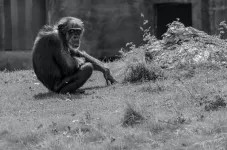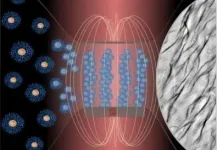INFORMATION:
BioScience, published monthly by Oxford Journals, is the journal of the American Institute of Biological Sciences (AIBS). BioScience is a forum for integrating the life sciences that publishes commentary and peer-reviewed articles. The journal has been published since 1964. AIBS is an organization for professional scientific societies and organizations, and individuals, involved with biology. AIBS provides decision-makers with high-quality, vetted information for the advancement of biology and society. Follow BioScience on Twitter @AIBSbiology.
Oxford Journals is a division of Oxford University Press. Oxford Journals publishes well over 300 academic and research journals covering a broad range of subject areas, two-thirds of which are published in collaboration with learned societies and other international organizations. The division has been publishing journals for more than a century, and as part of the world's oldest and largest university press, has more than 500 years of publishing expertise behind it. Follow Oxford Journals on Twitter @OxfordJournals.
Social distancing in the natural world: Strategies to detect and avoid disease
2021-02-10
(Press-News.org) The notion of social distancing rose to public prominence approximately a year ago, when health officials began recommending it as a way to slow the spread of the novel SARS-CoV-2 virus. Despite the novelty of the concept among many contemporary human audiences, social distancing has considerable precedent among animals.
Writing in BioScience, Mark Butler of Florida International University and Donald C. Behringer of the University of Florida outline the role of social distancing in nature and compare it with its human counterpart. They describe numerous animals in which distancing has evolved, including guppies, chimpanzees, birds, ants, and mice, among many others.
Often, say the authors, social distancing can mark substantial behavioral changes in otherwise highly social species. Butler and Behringer describe the seasonal migrations of spiny lobsters, which occur "en masse, strung out on the seafloor in dramatic single-file lines or queues." However, because juveniles are particularly susceptible to a virus known as PaV1, which can kill 90% of those infected, healthy lobsters detect and refuse to shelter alongside their diseased conspecifics.
Similarly, say the authors, chimpanzees are known to ostracize unwell group members, such as those infected with polio, and are also thought to benefit from a general avoidance of individuals outside their immediate group. Further examples abound, including among highly social house finches, which avoid experimentally sickened members of the same species, and three-spined stickleback fish, which avoid schools that contain ectoparasite-infected individuals. Some animals even deploy other strategies that resemble humans' disease precautions, such as ants that "use poisons to disinfect their colonies and prevent epizootics."
According to the authors, a key to animals' successful deployment of social distancing lies in their ability to effectively use cues--often olfactory--to detect sickened individuals. Indeed, animals are often able to "use social distancing effectively and efficiently." In contrast, humans are typically forced to rely on low-accuracy visual or auditory cues, such as feverish appearance or coughing, highlighting the importance of diagnostic testing for the effective reduction of disease transmission.
Butler and Behringer suggest that future study may further illuminate and inform human responses to disease: "The examples of social distancing in wild animals in the present article, although they are compelling, are likely a small fraction of those that actually exist in nature and reflect the limited investigations conducted thus far on this phenomenon in the wild. What lessons might we learn about the human experience with pandemics from an expanded view of diseases, their spread, and their prevention in nature?"
ELSE PRESS RELEASES FROM THIS DATE:
Not a living fossil: How the Coelacanth recently evolved dozens of new genes
2021-02-09
The capture of the first living Coelacanth, a mighty ocean predator, off the coast of South Africa caused quite a stir in 1938, 65 million years after its supposed extinction. It became known as a "living fossil" owing to its anatomy looking almost identical to the fossil record. But while the Coelacanth's body may have changed little, its genome tells another story.
Toronto scientists have now revealed that the African Coelacanth, Latimeria chalumnae, gained 62 new genes through encounters with other species 10 million years ago. Their findings are reported in the journal Molecular Biology ...
Why does love of bargain hunting run in families?
2021-02-09
Headlines like "Black Friday Shoppers Trampled in New York" and popular television shows such as "Extreme Couponing" remind us how crazy consumers can get about retail sales promotions. This enthusiasm for getting bargains has been termed "deal proneness."
Past research has indicated that, to some degree, people become deal prone through being taught by their parents. But a new paper, "Born to Shop? A Genetic Component of Deal Proneness," published in the Journal of the Association for Consumer Research, provides evidence that our genes also play a role in causing bargain-hunting enthusiasm.
To demonstrate this genetic factor, authors Robert Schindler, Vishal Lala, and Jeanette Taylor ...
Can super-Earth interior dynamics set the table for habitability?
2021-02-09
Washington, DC-- New research led by Carnegie's Yingwei Fei provides a framework for understanding the interiors of super-Earths--rocky exoplanets between 1.5 and 2 times the size of our home planet--which is a prerequisite to assess their potential for habitability. Planets of this size are among the most abundant in exoplanetary systems. The paper is published in Nature Communications.
"Although observations of an exoplanet's atmospheric composition will be the first way to search for signatures of life beyond Earth, many aspects of a planet's surface habitability are influenced by what's happening beneath the planet's surface, and that's where ...
Researching ways to improve sustainability and reduce waste in the seafood industry
2021-02-09
Nutritionists have been touting the health benefits of seafood for years. Dietary guidelines recommend that the average adult get at least two servings of seafood per week. But the push to increase our consumption of seafood can put a strain on the seafood industry and create more waste.
"Many fisheries are fully or overexploited," said Lekelia "Kiki" Jenkins, an associate professor at Arizona State University's School for the Future of Innovation in Society in the College of Global Futures. "We are pushing our fisheries to the brink that they can sustain. Meanwhile, consumers are wasting nearly half of the fish they buy. We need to understand our waste behaviors and put a mechanism into place so that we use what we catch."
Jenkins is researching ways to improve sustainability in ...
Sonoporation: Underlying mechanisms and applications in cellular regulation
2021-02-09
Announcing a new article publication for BIO Integration journal. In this review article the authors Yue Li, Zhiyi Chen and Shuping Ge from First Affiliated Hospital of University of South China, Hengyang, China and Tower Health and Drexel University, Philadelphia, PA, USA summarize current state of the art applications of microbubble-cell interactions and sonoporation effects to cellular functions.
Ultrasound combined with microbubble-mediated sonoporation has been applied to enhance drug or gene intracellular delivery. Sonoporation leads to the formation of openings in the cell membrane, triggered by ultrasound-mediated oscillations and destruction of microbubbles. Multiple mechanisms are involved in the occurrence ...
Nanocarriers in the enhancement of therapeutic efficacy of natural drugs
2021-02-09
Announcing a new article publication for BIO Integration journal. In this review article the authors Xiuling Li, Shunung Liang, Chee Hwee Tan, Shuwen Cao, Xiaoding Xu, Phei Er Saw and Wei Tao from Sun Yat-sen University, Guangzhou, China, Guangzhou University of Chinese Medicine, Guangzhou, China and Center for Harvard Medical School, Boston, MA, USA discuss the potential benefits of four plants endogenous to China and the enhancement of their therapeutic efficacy by nanotechnology intervention.
Plant derived natural products have been used for the treatment of various human diseases long before the intervention of modern medicine. The basis of modern medicine is still inspired by traditional medicine and therapies. However, ...
Scientists urge for investment now in highly potent vaccines to prevent the next pandemic
2021-02-09
LA JOLLA, CA--As new COVID-19 variants begin to throw vaccine efficacy in question, two leading scientists are calling for health agencies to invest in the development of vaccines that would be broadly effective against many different variants and strains of potential pandemic viruses.
In a END ...
Scientists create flexible biocompatible cilia that can be controlled by a magnet
2021-02-09
Researchers at the University of Campinas's Chemistry Institute (IQ-UNICAMP) in the state of São Paulo, Brazil, have developed a template-free technique to fabricate cilia of different sizes that mimic biological functions and have multiple applications, from directing fluids in microchannels to loading material into a cell, for example. The highly flexible cilia are based on polymer-coated iron oxide nanoparticles, and their motion can be controlled by a magnet.
In nature, cilia are microscopic hairlike structures found in large numbers on the surface of certain cells, causing currents ...
Can current smartphone technology tell you when a pandemic might come calling?
2021-02-09
Photoplethysmography (PPG) is a simple optical technique used to detect volumetric changes in peripheral blood circulation. It's used in smart watches, for example, to monitor pulse and heart rate, but PPG biosensors are also found in millions of smartphones, but without any current clinical applications.
In a study published online in the February 2021 issue of Chest, researchers at University of California San Diego School of Medicine, with industry collaborators, found that already embedded PPG in smartphones, in tandem with application software, could be used for remote clinical pulse oximetry to manage chronic cardiopulmonary disease and perhaps initial treatment and monitoring of persons affected in respiratory viral pandemics, such as COVID-19.
"Pulse oximetry monitoring ...
Design and deployment of COVID-19 technology responses and finding ways to make things
2021-02-09
As governments try to mitigate the spread of COVID-19, many are turning to contact tracing, including apps that track your location and electronic check-in QR codes. But with that technology come questions of personal safety, privacy, trust, control and collective action. So what can be done to improve these large-scale technological system roll-outs without infringing on a citizen's right to privacy?
"These systems are logging your physical social network," said Katina Michael, an Arizona State University professor at the School for the Future of Innovation in Society in the College of Global Futures and the School of Computing, Informatics and Decision Systems Engineering in the Ira A. Fulton Schools of Engineering. "The physical has become more ...



